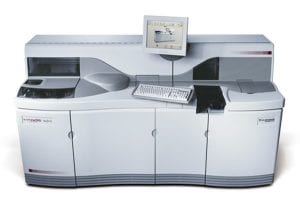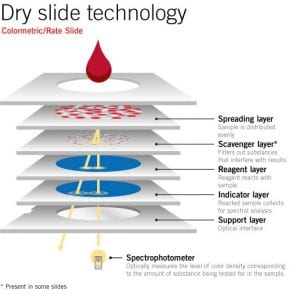It’s been a week since the start of clinical placement, and I can honestly say I’ve learned more than I thought I would considering how overwhelming the first few days were!
I spent this past week in the Chemistry department—specifically, getting to know the Vitros 5.1 analyzer.
As one might expect, there is a lot of automation in the lab. Considering the high volume and continual workflow of such a facility, it’s hard to imagine a time without the convenience of centrifuges, autosamplers, and even the platelet agitators in blood bank.
But technology cannot do everything and, more importantly, it creates its own challenges. Condition codes and delta checks can occur far more often than a student would think! It is the responsibility of a technologist to investigate these situations. For example – one might pull up a patient’s previous lab results to determine whether a markedly increased sodium (Na) is justified by a potential condition and its treatment, versus being a sample collection issue.
Error codes can arise from a wealth of circumstance: it could be a specific analyte not generating results, to problems with the system’s mechanics. Sometimes the solution is as straightforward as re-running the sample. Sometimes it’s not.
Troubleshooting is an unavoidable part of the profession and, as cliché as it sounds, it was important to take a step back and breathe when I wasn’t sure of what to do. Technologists have to be methodical in their work; job aids and other documentation on resolving issues won’t be all that effective if you’re too frazzled to follow them!
Be the first to receive the latest BCIT News. Become a subscriber.

For the most part, our labs at BCIT involved a set task to be completed with few interruptions. In the clinical lab, people are always moving and prioritization is key.
Mornings were the busiest time on the Vitros analyzer. Prior to running patient samples, lab techs take care of daily maintenance and run quality control (QC) samples. If the QC is flagged, one has to – you guessed it – troubleshoot. These materials are in place to assess the validity of the test system, as well as technologist technique; patient results cannot be reported out until they’ve passed.
It is also important to pay attention to inventory! The Vitros 5.1 analyzer uses dry slide technology to distribute the sample and filter it through several layers before being measured by a spectrophotometer. With hundreds of routine, urgent, and STAT specimens run each day and at one reaction per slide, I was restocking reagents a few times each shift.

One thing BCIT’s instilled in me is the attention to detail necessary to be successful as a lab tech. A quick visual inspection of each tube and asking yourself, has the sample been spun? Is there adequate volume for testing? Are the ordered tests actually run on this analyzer?
Make sure the answer is ‘yes’ before loading the sample, and you could save yourself a lot of confusion when you don’t get any results.
Learn more about the Medical Laboratory Science full-time diploma program at BCIT.

Its an excellent pleasure reading your post.Its packed with info i’m searching for and that i like to post a comment that “The content of your post is awesome” nice work.